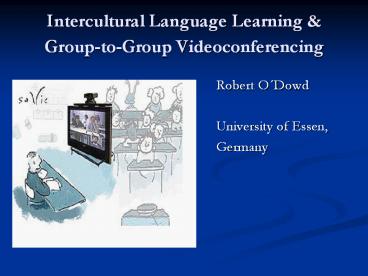Intercultural Language Learning - PowerPoint PPT Presentation
Title:
Intercultural Language Learning
Description:
Intercultural Language Learning & Group-to-Group Videoconferencing Robert O Dowd University of Essen, Germany – PowerPoint PPT presentation
Number of Views:307
Avg rating:3.0/5.0
Title: Intercultural Language Learning
1
Intercultural Language Learning Group-to-Group
Videoconferencing
- Robert ODowd
- University of Essen,
- Germany
2
Contact Learning
- Most teachers who have used the Internet have
started out with some kind of simple key pal
(computer pen pal) exchanges. And most teachers
who have used these exchanges have felt something
lacking. Simply put, there is no more reason to
except a significant educational outcome from
simply creating a pen pal connection than there
is from simply bringing two students into a room
and asking them to talk. - Mark Warschauer P. Fawn Whittaker (1997)
- http//iteslj.org/Articles/Warschauer-Internet.htm
l
3
The Challenge
- ...for communication to be meaningful, we need
to do more than link computers We need to
construct an approach to how others, in other
cultures, experience their world (Furstenberg et
al., 20012).
4
Overview
- What do language learners learn from contact?
- Towards an ethnographic approach
- Background on videoconferencing
- Videoconferencing in León
- Tasks
- Opportunities for intercultural Learning
- Guidelines and lessons learned
5
1. What are they looking for? Definitions of
culture
- Cristina (Spanish student)
- They live alone and not with their parents as
almost all Spanish students do - Marta (Spanish student)
- Like everybody else, some Americans are like
you and me and some are different.
6
2. Students receive information, but do not know
how to interpret it
- Interview with Cristina after videoconferences
with USA - Q What did you think of Americans before the
exchange? - A People who are always thinking of themselves
and dont care about others. - Q Did you get this impression from the
videoconference? - A Maybe, cos they did not seem very interested.
- Q All of them?
- A No, but that boy who was drinking coffee he
wasnt serious at all.
7
Intercultural Communicative Competence (Byram
1997)
- Attitudes of curiosity and openness
- Knowledge of social groups and their products and
practices in both cultures - Skills of discovery and interaction how to
acquire new knowledge about a culture - Skill of interpreting a document or event from
another culture ...and relating it to documents
from ones own culture - Critical cultural awareness
8
Students as ethnographers
- A move away from an encyclopaedic approach of
seeing culture as a collection of facts and
figures to - an ethnographic approach the study of a
groups social and cultural practices from an
insiders perspective (Roberts et al. 2001)
9
Spradley on Ethnography (19796)
- we do not eliminate an interest in behavior,
customs, objects, or emotions. We have merely
shifted the emphasis from these phenomena to
their meaning. The ethnographer observes
behavior, but goes beyond it to inquire about the
meaning of that behavior.
10
Videoconferencing in Foreign Language Learning
- Teacher-Class
- Traditional teacher-led instruction
- Student-Student
- Tandem-Style intercambios
- Class-Class
- Presentation, debate and group discussion
11
Videoconferencing Exchanges 1999-2001
- Universidad de León, Spain.
- 2nd Years Students of English.
- Connections Made
- http//www.iecc.org/
- http//www.ialic.org
- Partner Classes
- Students of Spanish at
- University of Michigan, USA.
- University of Dundee
- University of Nottingham
12
Videoconferencing Facilities
- Large view of other group and own group on screen
- Pictures and text can be presented on screen via
projector - Video clips can also be shown on main screen
13
Task Cycle
14
Some Examples of Tasks
- Students present products or practices from their
home culture which they think might be strange or
different for the other group (e.g. Easter in
Spain) - Comparative reviews of films
- Both groups try to agree on punishments for
controversial crimes
15
How Can Videoconferencing Contribute to
Intercultural Learning?
- 1. Presentations by members of the target culture
- Insight into the foreign perspective
- Explanations of products and practices are
supported through media and demonstrations
16
How Can Videoconferencing Contribute to
Intercultural Learning?
- 2. Discussion and debate brings about
- Better understanding of the reasoning and values
that underly beliefs and behaviour in the target
culture - Practice in negotiation and interaction with
members of the target culture
17
Drawbacks of the Technology
- Time delay between sound and image
- Rules of interaction Turn taking, interruptions
and simultaneous starts - Passive viewing
- Organisational practicalities
18
Practical Guidelines
- Integrate visual materials (photos, video,
overheads, real objects) - Give the sessions a clear structure beforehand
- Begin with icebreakers such as quizzes or
vocabulary games - Make clear to whom comments and questions are
directed - Use non-verbal signals to show understanding
19
Pedagogical Guidelines
- Add-on v. integrated approaches
- Balance personal views with statistics and
factual material - Follow-up discussions and feedback
- Reciprocity in language use and workload
20
All Contact Welcome
- Robert.odowd_at_uni-essen.de
- http//www.uni-essen.de/odowd/vcing2002
21
Bibliography (1)
- Byram, M. (1997) Teaching and Assessing
Intercultural Communicative Competence.
Multilingual Matters. - Feldman, A. (2000) Network science A decade
later. - Furstenberg, G. et al. (2001) Giving a virtual
voice to the silent language of culture The
Cultura project Language Learning and Technology
(Vol. 51). http//llt.msu.edu/vol5num1/furstenber
g/ - Intercultural E-mail Classroom Connections
http//www.iecc.org/
22
Bibliography (2)
- International Association for Languages and
Intercultural Communication. http//www.ialic.org - Roberts, C. et al. (2001) Language Learners as
ethnographers. Multilingual Matters. - Spradley, J. (1979) The ethnographic interview.
Hold, Rinehart and Winston Inc. - Warschauer, M. Whitaker, P. (1997) The Internet
for English teaching Guidlines for teachers The
Internet TESOL Journal (Vol 310)
http//iteslj.org/Articles/Warschauer-Internet.htm
l































